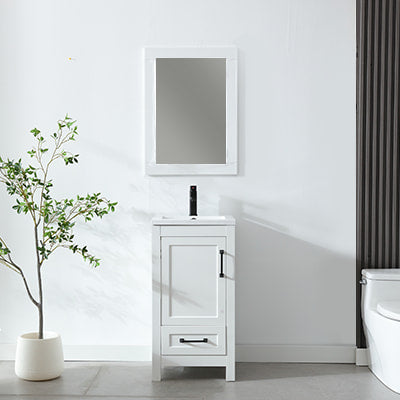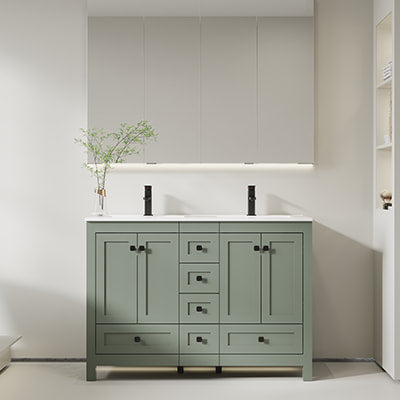Has a squeaky bathroom vanity drawer ever jarred you awake on a quiet morning? Do you find yourself wincing at the grating sound every time you open or close it? While a noisy drawer might seem like a minor nuisance, it's enough to ruin your morning calm. More importantly, persistent squeaking can be a warning sign of impending damage. Ignoring it could lead to more serious repairs down the line.
The good news is that fixing this issue typically requires no professional skills or specialized tools. This guide willconduct a detailed analysis the reasons behind those irritating sounds and provide a comprehensive, step-by-step solution to restore peace and quiet to your bathroom.
Why Does Your Bathroom Vanity Drawer Squeak?
 Understanding the root cause is the first step to an effective fix. The primary culprits for a squeaky drawer are:
Understanding the root cause is the first step to an effective fix. The primary culprits for a squeaky drawer are:
1. Wood Expansion and Warping: Bathrooms are humid environments. Wooden drawers absorb moisture and expand, leading to friction against the cabinet frame or slides.
2. Slide/Rail Issues: This is the most common source of noise. Lack of lubrication, loose screws, or misaligned tracks can all cause squeaking.
3. Component Wear: With prolonged use, rollers, wheels, or the slides themselves can wear down, increasing friction.
4. Foreign Debris: Small objects, dust, or hair can get trapped in the sliding mechanism, obstructing smooth movement.
5. Improper Installation: An unbalanced drawer or loose screws can cause misalignment and abnormal friction.
With these causes in mind, we can target the solution effectively.
Preparation: Tools and Materials You'll Need
 Before you begin, gather these items:
Before you begin, gather these items:
-
Screwdrivers (flat-head and Phillips)
-
Lubricant (Silicone-based lubricant is ideal. Avoid WD-40 for this purpose as it's a penetrant, not a long-term lubricant).
-
A candle or a dedicated wax stick for wood.
-
Soft cloths and a mild cleaner.
-
Sandpaper (medium grit).
-
Potential replacement parts (e.g., rollers, slides).
Safety First: Always empty the drawer completely and remove it from the cabinet before starting any work to prevent injury or damage to contents.
Step 1: Diagnose the Source of the Sound
Before removing the drawer, open and close it a few times. Listen carefully to pinpoint the origin of the noise. Is it coming from the metal slides? Or is it wood rubbing against wood? Gently press on different parts of the drawer while operating it to see if the sound changes. This will help you focus your repair efforts.
Step 2: Clean the Slides and Rollers Thoroughly
 More than 50% of drawer noise problems can be solved by simple cleaning:
More than 50% of drawer noise problems can be solved by simple cleaning:
1. Gently pull the drawer to its fullest extension. There are usually release clips or levers on both sides (or underneath) – engage them to fully detach the drawer.
2. Use a soft cloth and cleaner to wipe down the entire length of the tracks and the rollers/wheels, removing all dust, hair, and grime.
3. Inspect the slides for any signs of obvious wear, bending, or damage.
4. Clean the corresponding glide mechanisms on the sides of the drawer itself.
Step 3: Lubrication is Key
 After cleaning, proper lubrication is the most effective way to silence squeaks:
After cleaning, proper lubrication is the most effective way to silence squeaks:
-
Choose the right lubricant: A silicone-based spray is preferred because it doesn't damage wood, doesn't attract dust, and is water-resistant.
-
Apply a small amount sparingly and evenly to the contact surfaces of the slides.
-
Slide the drawer in and out several times to distribute the lubricant evenly.
-
Wipe away any excess lubricant with a cloth to prevent it from attracting dirt or getting onto your belongings.
Crucial Tip: Avoid over-lubrication, as this can attract more dust and create a gummy residue over time.
Step 4: Adjust and Tighten
 If cleaning and lubricating don't solve the problem, the issue might be loose components or misalignment:
If cleaning and lubricating don't solve the problem, the issue might be loose components or misalignment:
1. Check and tighten all screws, especially those securing the slides to the cabinet and the drawer.
2. If the drawer appears crooked or unbalanced, adjust the position of the slides.
3. For metal slide systems, check for bent sections. You can carefully straighten minor bends with pliers.
Step 5: Address Wood-on-Wood Friction
 If your vanity has wooden guides or the drawer itself is rubbing against the frame:
If your vanity has wooden guides or the drawer itself is rubbing against the frame:
1. Identify the friction point: Rub a candle, a piece of chalk, or a wax stick on the suspected areas. Reinstall the drawer and operate it a few times. The friction point will become apparent where the wax or chalk is worn away.
2. Lightly sand the identified friction point on the drawer. Be cautious not to remove too much material, as this can create an overly large gap.
3. Rub a candle or wax stick generously on the sanded area and the corresponding contact point inside the cabinet to create a smooth, low-friction coating.
Step 6: Check and Replace Worn-Out Parts
 If all else fails, components may be severely worn:
If all else fails, components may be severely worn:
1. Check if the rollers or wheels are worn down or cracked. Replace them if necessary.
2. Inspect the slide mechanism for significant damage or deformation.
3. Purchase replacement slides or parts of the exact same model and install them according to the manufacturer's instructions.
Special Considerations for Different Vanity Types
-
Solid Wood Vanities: More susceptible to humidity-related expansion. You may need seasonal adjustments. Consider using a dehumidifier to control bathroom moisture levels.
-
Metal Slide Systems: Regular lubrication is crucial. Check for signs of rust.
-
Plastic Components: Avoid petroleum-based lubricants, which can degrade certain plastics.
Preventive Measures: Avoiding Future Squeaks
1. Clean and lubricate drawer slides every 6 months as part of your home maintenance routine.
2. Maintain proper bathroom ventilation to control humidity.
3. Avoid overloading the drawer and distribute weight evenly.
4. Always open and close drawers gently, avoiding sudden, forceful impacts.
When to Call a Professional?
If you've tried all these methods without success, or if you discover significant structural damage to the drawer or cabinet, it might be time to consult a professional repair service. However, in the vast majority of cases, the steps outlined above will resolve the issue effectively.
Conclusion
Fixing a squeaky bathroom vanity drawer does more than just eliminate an annoying sound—it extends the life of your furniture and provides a satisfying sense of accomplishment. With minimal time and effort, you can restore a quiet and harmonious atmosphere to your home.
Now, go ahead and inspect your bathroom vanity drawer! With this guide, you are well-equipped to solve the problem smoothly. If you have your own repair tips or questions, please feel free to share them in the comments section below.





